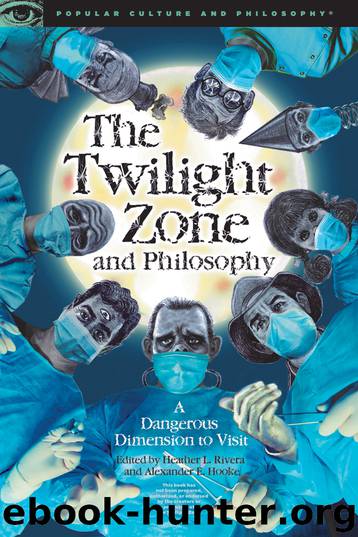The Twilight Zone and Philosophy by Heather L. Rivera

Author:Heather L. Rivera
Language: eng
Format: epub
ISBN: 9780812699937
Publisher: Open Court
Published: 2018-08-11T16:00:00+00:00
13
No Place Like a Non-Place
FERNANDO GABRIEL PAGNONI BERNS, JUAN IGNACIO JUVÉ, AND EMILIANO AGUILAR
Empty streets. Empty roads. Empty gas stations. Empty bars. Empty worlds.
The Twilight Zone was many things: science fiction, fantasy, horror, and sometimes, comedy, but it always preferred stories revolving around crisis of identity and paranoia against the backdrop of the American Dream. In this context, the show illustrated the emptiness haunting American citizens in the consumerist 1950s. Even at the time, a host of books and intellectuals criticized the impact of consumerism and conformity in the era. The empty spaces privileged by the narrative were echoes of the emptiness felt by inauthentic, alienated characters.
Rod Serling, creator of the idea and the series, belonged to the school of California horror that included, among others, writers such as Richard Matheson, Charles Beaumont, Harlan Ellison, and George Clayton Johnson. All of them wrote for the show at some point in their careers. These men were, from the early 1950s to the mid-1960s, part of a brotherhood of writers centered in the Los Angeles area. According to Matt Cardin, they “founded their sense of the fantastic in everyday reality and in the experience of characters who might live next door if not in the reader’s own house” rather than in foreign monstrosities embodied in figures such as the Count from Transylvania or the exotic walking mummy.
The geographical location is notable: California, and more particularly Hollywood, the place where identities are stripped down and recreated, where people come and go, often unnoticed.
The French philosopher and anthropologist Marc Augé used the term “non-place” to refer to places of transit that do not hold enough significance to be regarded properly as “places.” Examples include motorway routes, airports, hotel rooms, and shopping malls. Places where there is no sense of belonging, places that favored lack of connectivity with anything of meaning or with other persons. The contemporary modern world is increasingly characterized by such “non-places.” Nineteen-fifties Hollywood might also be classified as a non-place.
Non-places are the best of places to speak about loneliness and alienation. Thus, many of the best episodes of The Twilight Zone were constructed around this particular motif: “Will the Real Martian Please Step Up?,” “The Four of Us Are Dying,” “The Hitch-Hiker,” “The After Hours,” “The Passersby,” “Passage on the Lady Anne,” and, of course, the instant classic “Nightmare at 20,000 Feet,” among many others.
American Dream or American Nightmare?
Unlike the pulp fiction dominating the markets, the writers of the California school of horror wrote about fantastic adventures taking place in the lives of common people residing in the suburbs. Of course, alien landscapes, rocket ships and amazing planets were part of the stuff of their tales, but all these elements were used to speak about down-to-earth human nature, in a very down-to-earth way.
The Twilight Zone was created in the postwar period, a time when traditional notions of gender were being re-organized. On the one hand, masculinity was framed by fears that arose when women joined the public workplace in record numbers due to the scarcity of men, who were occupied fighting in the battlefield.
Download
This site does not store any files on its server. We only index and link to content provided by other sites. Please contact the content providers to delete copyright contents if any and email us, we'll remove relevant links or contents immediately.
| Anthropology | Archaeology |
| Philosophy | Politics & Government |
| Social Sciences | Sociology |
| Women's Studies |
The remains of the day by Kazuo Ishiguro(8791)
Tools of Titans by Timothy Ferriss(8187)
Giovanni's Room by James Baldwin(7164)
The Black Swan by Nassim Nicholas Taleb(6989)
Inner Engineering: A Yogi's Guide to Joy by Sadhguru(6706)
The Way of Zen by Alan W. Watts(6483)
Asking the Right Questions: A Guide to Critical Thinking by M. Neil Browne & Stuart M. Keeley(5604)
The Power of Now: A Guide to Spiritual Enlightenment by Eckhart Tolle(5584)
The Six Wives Of Henry VIII (WOMEN IN HISTORY) by Fraser Antonia(5381)
Astrophysics for People in a Hurry by Neil DeGrasse Tyson(5122)
Housekeeping by Marilynne Robinson(4306)
12 Rules for Life by Jordan B. Peterson(4239)
Double Down (Diary of a Wimpy Kid Book 11) by Jeff Kinney(4183)
The Ethical Slut by Janet W. Hardy(4163)
Skin in the Game by Nassim Nicholas Taleb(4144)
Ikigai by Héctor García & Francesc Miralles(4103)
The Art of Happiness by The Dalai Lama(4051)
Skin in the Game: Hidden Asymmetries in Daily Life by Nassim Nicholas Taleb(3907)
Walking by Henry David Thoreau(3879)
